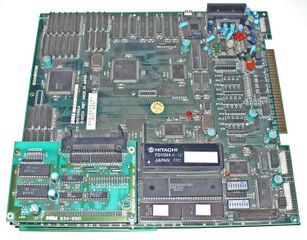Difference between revisions of "Sega System 24"
From Sega Retro
| Line 5: | Line 5: | ||
| name= | | name= | ||
| maker=[[Sega]] | | maker=[[Sega]] | ||
| + | | processor=[[FD1094]], [[68000]] | ||
| releases={{releases | | releases={{releases | ||
| arcade_date_jp=1988-04 | | arcade_date_jp=1988-04 | ||
Revision as of 11:05, 27 November 2015

| |||||
| Sega System 24 | |||||
|---|---|---|---|---|---|
| Manufacturer: Sega | |||||
|
The Sega System 24 is an arcade platform released by Sega in the late 1980s. The System 24 is quite different from other "System" arcade boards - primarily it handles high resolution games with more colours, rather than serving as a direct successor to the standard Sega System 16 arcade hardware (this task was reserved for the Sega System 32).
Specifications
The System 24 uses two Motorola 68000 processors at 10 MHz. One is for booting, while the other is used by the game. The board holds 1360KB of RAM and 256kB of ROM, and was the first Sega arcade system that required a medium resolution arcade monitor. 4352 colors can be used on-screen from a selectable 32,768, or with shadow & highlight, 16,384 colors on screen selectable from 98,304. [1] The system can support up to 2048 sprites on-screen at once.
Sound is driven by a YM2151 at 4MHz; it is capable of delivering 8 channels of FM sound in addition to a DAC used for sound effects and speech synthesis. Early System 24s loaded their program off of floppy disks. Some later games such as Bonanza Bros. use CD-ROMs or hardware ROM boards as storage. No matter which storage device is used, a special security chip is required for each game an operator wants to play.
Technical Specifications
- CPU: Hitachi FD1094 @ 10 MHz & Motorola 68000 @ 10 MHz (16-bit & 32-bit instructions @ 3.5 MIPS) [1]
- Sound chips: Yamaha YM2151 @ 4 MHz (8 FM synthesis channels), DAC (sound effects and speech synthesis)
- Audio output: Stereo speakers, stereo headphones
- GPU chipset: Sega 315-5242 Color Encoder 315-5292 Tilemap Generator, 315-5293 Sprite Generator, 315-5294 Priority Mixer, 315-5295 Object Generator [1]
- Graphical capabilities: Sprite zoom, scrolling, row & column scrolling, parallax scrolling
- Internal memory: 1616 KB
- Storage media: Floppy disk, ROM board
- Resolution: 496×384 (display), 656×424 (overscan),[2] progressive scan
- Color palette: 98,304 (32,768 colors with shadow & highlight)
- 16-bit color palette: 15-bit RGB high color depth (32,768 colors) and 1-bit shadow & highlight that triples up to 98,304 colors
- Colors on screen: 16,384 [2] (4352 colors with shadow & highlight)
- Tilemaps:
- Tilemap layers: 4 (2 scrolling and 2 windowed)
- Tile size: 8×8 pixels
- Tiles per scrolling tilemap: 4096
- Scrolling tilemap size: 512×512 pixels
- Sprites:
- Colors per sprite: 16 to 256
- Sprite size: 8 to 1024 pixels in width/height
- Sprite virtual space: 4096×4096 pixels
- Sprite pixels/texels per scanline: 4096
- Sprites per scanline: 512
- Sprites on screen: 2048
- Framebuffers: Dual framebuffers @ 512×384 pixels each, double buffering
Games
- Hot Rod (1988)
- Hot Rod Turbo (1988)
- Scramble Spirits (1988)
- Gain Ground (1988)
- Crack Down (1989)
- Super Masters (1989)
- Bonanza Bros. (1990)
- Rough Racer (1990)
- Dynamic Country Club (1991)
- Quiz Syukudai wo Wasuremashita (1991)
- Tokoro San no MahMahjan (1992)
- Quiz Mekurumeku Story (1993)
- Quiz Ghost Hunter (1994)
- Tokoro San no MahMahjan 2 (1994)
- Quiz Magical Brain (1996)
- Quiz Rouka ni Tattenasai! (1996)
Physical Scans
External links
| Sega arcade boards |
|---|
| Originating in arcades |
|
77
78
79
80
81
82
83
84
85
86
87
88
89
90
91
92
93
94
95
96
97
98
99
|
| Console-based hardware |
|
84
85
86
87
88
89
90
91
92
93
94
95
96
97
98
99
00
01
02
03
04
05
06
07
08
09
10
11
12
13
14
|
| PC-based hardware |
|
05
06
07
08
09
10
11
12
13
14
15
16
17
18
19
20
21
22
23
|
